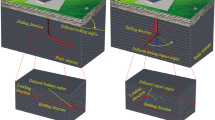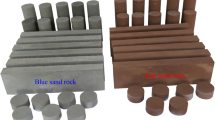Abstract
Elastic properties of enclosing rock mass around Botuobinskaya pipe diamond deposit are studied using the standard STO 05282612–001–2913. The Standard is based on an original procedure for determination of static elastic properties of materials under change in temperature or moisture content, which is inprovided by Russian and international standard but is of practical value in mine planning and design in the permafrost zone. A sample is subjected to multiple loading in the range of low irreversible strains, which improves measurement accuracy and enables physically correct estimation of temperature and water content influence on change of properties in a material in transition from thawed to frozen state. Based on the findings, the mechanisms of change in elastic properties of hard rocks are determined in a wide temperature range. It is emphasized that the change in elastic properties exhibits essentially nonlinear dependence on water content.
Similar content being viewed by others
References
Mellor M., Mechanical Properties of Rocks at Low Temperatures, Permafrost: North American Contribution to the Second Int. Conf., Washington: Nat. Acad. Sci., 1973.
Inada Y. and Yokota K., Some Studies of Low Temperature Rock Strength, Int. J. Rock Mech. Min. Sci. Geomech. Abstr, 1984, vol. 21, no. 3, pp. 145–153.
Särkkä, P. and Pöllä, J., Strength and Deformation Characteristics of a Gabbro Rock between–10 °C and–60 °C, Safety and Environmental Issues in Rock Engineering: Proc. Int. Symp. Eurock 93, Rotterdam: Balkema, 1993.
Yamabe T. and Neaupane K.M., Determination of Some Thermo-Mechanical Properties of Sirahama Sandstone under Subzero Temperature Condition, Int. J. Rock Mech. Min. Sci., 2001, vol. 38, no. 7, pp. 1029–1034.
Liu Q.S., Xu G.M., Hu Y.H., and Chang X., Study on Basic Mechanical Behaviors of Rocks at Low Temperatures, Key Engineering Materials, 2006, vol. 306–308, pp. 1479–1484.
Chen Y., Azzam R., Wang M., Xu S., and Chang L., The Uniaxial Compressive and Tensile Tests of Frozen Saturated Clay in Shanghai Area, Environ. Earth Sci., 2011, vol. 64, no. 1, pp. 29–36.
Kodama J., Goto T., Fujii Y., and Hagan P., The Effects of Water Content, Temperature and Loading Rate on Strength and Failure Process of Frozen Rocks, Int. J. Rock Mech. Min. Sci., 2013, vol. 62, pp. 1–13.
Al-Omari A., Brunetaud X., Beck K., and Al-Mukhtar M., Coupled Thermal–Hygric Characterisation of Elastic Behaviour for Soft and Porous Limestone, Constr. Build. Mater, 2014, vol. 62, pp. 28–37.
USSR State Standard GOST 28985–91. Rocks. Method for Determining Strain Characteristics under Uniaxial Compression. Moscow: Izd. Standartov, 2004.
ASTM D7012–10. Standard Test Method for Compressive Strength and Elastic Moduli of Intact Rock Core Specimens under Varying States of Stress and Temperatures, West Conshohocken: ASTM Int., 2010.
German Standard DIN EN 14580:2005–07. Prüfverfahren für Naturstein—Bestimmung des Statischen Elastizitätsmoduls, Berlin: Deutsches Institut für Normung e.V., 2005.
Brown E.T. (Ed.), ISRM Suggested Methods. Rock Characterization Testing and Monitoring, Oxford: Pergamon Press, 1981.
Martin C.D. and Chandler N.A., The Progressive Fracture of Lac du Bonnet Granite, Int. J. Rock Mech. Min. Sci. & Geomech. Abstr, 1994, vol. 31, no. 6, pp. 643–659.
Eberhardt E., Stead D., Stimpson B., and Read R. S., Identifying Crack Initiation and Propagation Thresholds in Brittle Rock, Can. Geotech. J., 1998, vol. 35, no. 2, pp. 222–233.
Hakala M., Kuula H., and Hudson J.A. Estimating the Transversely Isotropic Elastic Intact Rock Properties for In Situ Stress Measurement Data Reduction: A Case Study of the Olkiluoto Mica Gneiss, Finland, Int. J. Rock Mech. Min. Sci., 2007, vol. 44, no. 1, pp. 14–46.
Suknev S.V., Procedure for Static Elasticity Modulus and Poisson’s Ratio Determining in Sample Temperature Change, GIAB, 2013, no. 8, pp. 101–105.
Suknev S.V., Determination of Elastic Properties of Rocks under Varying Temperature, J.Min. Sci., 2016, vol. 52, no. 2, pp. 161–171.
Suknev S.V., Experience of Developing and Applying the Organization Standard to Determine Elastic Properties of Rocks, Gornyi Zhurnal, 2015, no. 4, pp. 20–25.
Acknowledgments
The author is grateful to A. I. Rukavishnikov and N. V. Popov for their help in preparing the samples and conducting the tests.
Funding
The study was conducted in the framework of the Basic Research Program, Siberian Branch of the Russian Academy of Sciences, project no. 0382–2018–0002, and also was supported by Russian Foundation for Basic Research, project no. 15–45–05014.
Author information
Authors and Affiliations
Corresponding author
Additional information
Original Russian Text © The Author(s), 2019, published in Fiziko-Tekhnicheskie Problemy Razrabotki Poleznykh Iskopaemykh, 2019, No. 2, pp. 14–22.
Rights and permissions
About this article
Cite this article
Suknev, S.V. Influence of Temperature and Water Content on Elastic Properties of Hard Rocks in Thaw/Freeze State Transition. J Min Sci 55, 185–193 (2019). https://doi.org/10.1134/S1062739119025444
Received:
Revised:
Accepted:
Published:
Issue Date:
DOI: https://doi.org/10.1134/S1062739119025444




